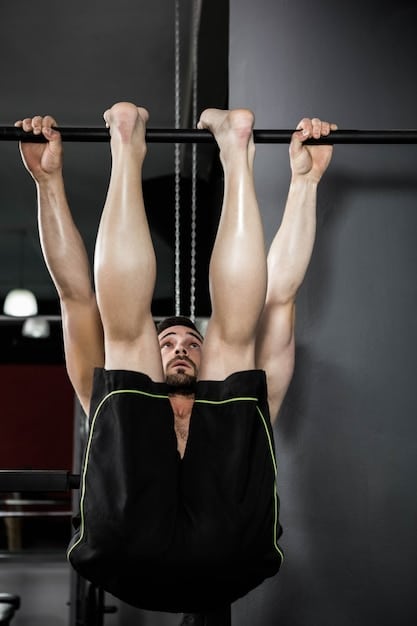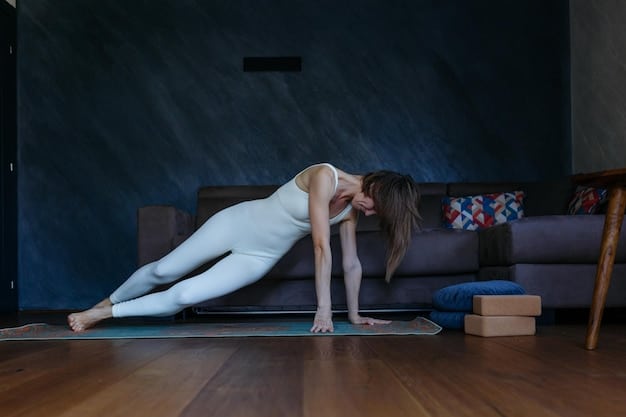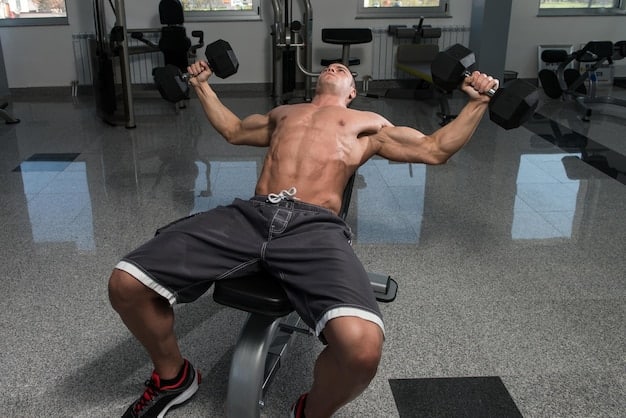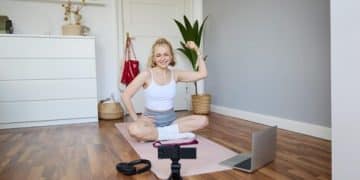Build a Six-Pack: The 3 Core Exercises You Need

Build a Six-Pack: The 3 Core Exercises You Need to Do focuses on core strength, stability and definition, targeting the rectus abdominis, obliques, and transverse abdominis. These exercises involve compound movements that engage multiple muscle groups, contributing to overall fitness and muscle development.
Want to develop a defined six-pack? It’s more achievable than you might think! While genetics and body fat percentage play a role, the right exercises can make a significant difference. This guide will walk you through the essential movements to build a six-pack: the 3 core exercises you need to do. Forget endless crunches; we’re focusing on exercises that engage your entire core for maximum results.
Ready to ditch the sit-ups and discover how to build a six-pack: the 3 core exercises you need to do effectively? Let’s dive in and unlock the secrets to a stronger, more defined midsection. These movements will not only help you build a six-pack: the 3 core exercises you need to do, but also improve your overall functional fitness.
Build a Six-Pack: Understanding the Core
Before diving into the exercises, it’s crucial to understand what we mean by “core.” Your core isn’t just your abdominal muscles; it’s a complex group of muscles that stabilize your spine and pelvis. It includes the rectus abdominis (the “six-pack” muscle), obliques (which run along the sides of your torso), transverse abdominis (a deep muscle that acts like a corset), and even muscles in your back and hips.
Why Core Strength Matters
Core strength isn’t just about aesthetics. It improves your posture, reduces back pain, enhances athletic performance, and makes everyday movements easier. A strong core allows you to transfer power efficiently between your upper and lower body.
The Importance of a Holistic Approach
While the exercises we’ll cover are highly effective, remember that seeing a visible six-pack requires a holistic approach. This includes a balanced diet, regular cardiovascular exercise, and sufficient rest. Spot reduction of fat is a myth; you need to reduce overall body fat to reveal your hard-earned abs.

In summary, understanding the core and adopting a holistic approach encompassing diet, cardio, and rest alongside targeted exercises are the keys to effectively building a six-pack.
Exercise 1: The Plank – Your Foundation for a Strong Core
The plank is an isometric exercise, meaning you hold a static position. It primarily targets the transverse abdominis but also engages the rectus abdominis, obliques, and muscles in your shoulders, back, and glutes. It’s a fantastic exercise to build a solid foundation for core strength.
Proper Plank Form
- Start in a push-up position, but instead of placing your hands on the floor, rest on your forearms.
- Ensure your body forms a straight line from head to heels.
- Engage your core by drawing your belly button towards your spine.
- Avoid sagging your hips or arching your back.
- Hold the position for as long as you can maintain good form.
Progressive Overload with Planks
Start by holding the plank for 30 seconds and gradually increase the duration as you get stronger. You can also add variations like forearm plank with hip dips, plank jacks, or walking planks to challenge yourself further.
Common Mistakes to Avoid
One common mistake is letting your hips sag towards the floor, which puts strain on your lower back. Another is hiking your hips too high, which reduces core engagement. Focus on maintaining a straight line and engaging your core throughout the exercise.
The plank is a foundational exercise of ‘fitness and nutrition’ that strengthens the core, improves posture, and enhances overall stability. Mastering the plank will pave the way for more advanced core exercises that are needed to build a six-pack: the 3 core exercises you need to do.
Exercise 2: Hanging Leg Raises – A Dynamic Core Challenge
Hanging leg raises are a more advanced exercise that targets the lower abs and hip flexors. This dynamic movement requires significant core strength and stability. They are an excellent way to challenge your core beyond static holds like planks. You can **build a six-pack: the 3 core exercises you need to do** with hanging leg raises, improving core strength and muscle definition.

Performing Hanging Leg Raises Correctly
- Hang from a pull-up bar with an overhand grip, shoulder-width apart.
- Engage your core and stabilize your body.
- Slowly raise your legs, keeping them straight or slightly bent, until your thighs are parallel to the floor.
- Control the movement as you slowly lower your legs back to the starting position.
Variations to Increase Difficulty
Once you can perform standard hanging leg raises with good form, you can increase the difficulty by performing them with straight legs, adding a twist at the top of the movement to engage your obliques, or using ankle weights.
Tips for Beginners
If you’re new to hanging leg raises, start with bent-knee raises. This reduces the lever arm and makes the exercise easier. You can also use an assisted pull-up machine to support some of your body weight.
Hanging leg raises are a fantastic exercise that when executed properly, challenge your core dynamically, building strength, stability, and definition. By incorporating hanging leg raises into your routine, you’ll be well on your way to build a six-pack: the 3 core exercises you need to do.
Exercise 3: Russian Twists – Targeting Your Obliques
Russian twists primarily target your obliques, the muscles that run along the sides of your torso. This exercise involves rotation, which helps to sculpt your waistline and improve core stability. It also engages the rectus abdominis and lower back muscles.
Proper Russian Twist Technique
Sit on the floor with your knees bent and feet either on the ground or slightly elevated. Lean back slightly, maintaining a straight back. Hold a weight or medicine ball in your hands. Rotate your torso from side to side, touching the weight to the floor on each side.
Modifications for Different Fitness Levels
- To make the exercise easier, keep your feet on the ground and don’t use any weight.
- To make it more challenging, lift your feet off the ground and use a heavier weight.
- You can also increase the range of motion by rotating further to each side.
Common Mistakes to Avoid
Avoid rounding your back, as this can put strain on your spine. Focus on rotating from your torso, not just moving your arms. Maintain a controlled pace throughout the exercise.
The Russian twist is an effective exercise to target your obliques, sculpt your waistline, and enhance rotational core strength. In conclusion, Russian twists can be effective for those trying to build a six-pack: the 3 core exercises you need to do.
Integrating These Exercises Into Your Routine
Now that you know the three core exercises, let’s discuss how to integrate them into your workout routine. The key is consistency and progressive overload. Start with a manageable number of sets and reps, and gradually increase the intensity as you get stronger. Frequency is important to build a six-pack: the 3 core exercises you need to do.
Sample Workout Schedule
Here’s a sample workout schedule you can follow:
- Monday: Plank (3 sets, hold for as long as possible with good form), Russian Twists (3 sets of 15-20 reps per side)
- Wednesday: Hanging Leg Raises (3 sets of 10-15 reps), Plank (3 sets, hold for as long as possible with good form)
- Friday: Russian Twists (3 sets of 15-20 reps per side), Hanging Leg Raises (3 sets of 10-15 reps)
The Importance of Rest and Recovery
Your muscles need time to recover and rebuild after each workout. Aim for at least one rest day between core workouts. Adequate sleep and proper nutrition are also essential for muscle recovery and growth.
Tracking Your Progress
Keep track of your sets, reps, and hold times in a workout journal or app. This will help you monitor your progress and identify areas where you need to push yourself harder.
Integrating these exercises into your routine requires consistency, progressive overload, proper rest, and tracking your progress. Remember, building a visible six-pack takes time and dedication, but with the right approach, it’s definitely achievable.
Beyond the Gym: Core Engagement in Daily Life
Building a strong core isn’t just about what you do in the gym. You can also engage your core in everyday activities. Practicing proper posture while sitting, standing, and walking can help to activate your core muscles and improve stability. Simple tasks can help you build a six-pack: the 3 core exercises you need to do when done the right way.
Conscious Core Activation
Throughout the day, take a few moments to consciously engage your core by drawing your belly button towards your spine. This can be done while you’re sitting at your desk, waiting in line, or even watching TV.
Functional Movements
Pay attention to how you lift and carry objects. Bend at your knees and keep your back straight, engaging your core to stabilize your spine. Avoid twisting or jerking movements, which can put strain on your back.
Mindful Movement
Be mindful of your body mechanics in all your activities. Whether you’re gardening, playing with your kids, or doing household chores, focus on using your core to support your movements. It is important that you build a six-pack: the 3 core exercises you need to do, but that these exercises also support your movements in your daily life.
Core engagement in daily life involves conscious activation of core muscles and mindful movement patterns. By integrating core engagement into your daily activities, you can further enhance your core strength, stability, and overall functional fitness.
| Key Point | Brief Description |
|---|---|
| 💪 Core Exercises | Plank, Hanging Leg Raises, Russian Twists |
| 🏋️ Holistic Approach | Diet, cardio, and regular exercises are key. |
| ⏱️ Consistency | Regular training is essential. |
| 🧘 Core Engagement | Activate muscles during everyday actions. |
FAQ
The plank, hanging leg raises, and Russian twists are highly effective for targeting different core muscles. It is also important to incorporate a holistic fitness strategy.
Aim for 2-3 core workouts per week, with at least one rest day in between to allow your muscles to recover and rebuild. Focus on proper form to maximize results.
Yes, bodyweight exercises like planks and hanging leg raises can be very effective. You can add weights as you get stronger to further challenge your core. In fact, focusing on weights only may not be as effective as building a six pack.
Results vary depending on factors like genetics, body fat percentage, and consistency. With a dedicated approach, you may start to see noticeable changes in a few weeks.
Absolutely! Reducing overall body fat is essential for revealing your abs. Focus on a balanced diet with plenty of protein, fruits, and vegetables. This is especially useful to build a six-pack: the 3 core exercises you need to do.
Conclusion
Building a six-pack requires a multifaceted approach that includes targeted exercises, a balanced diet, and consistent effort. By incorporating the plank, hanging leg raises, and Russian twists into your routine, you can strengthen your core, improve stability, and sculpt your abs. Remember to practice proper form, progressively overload your muscles, and prioritize rest and recovery.





